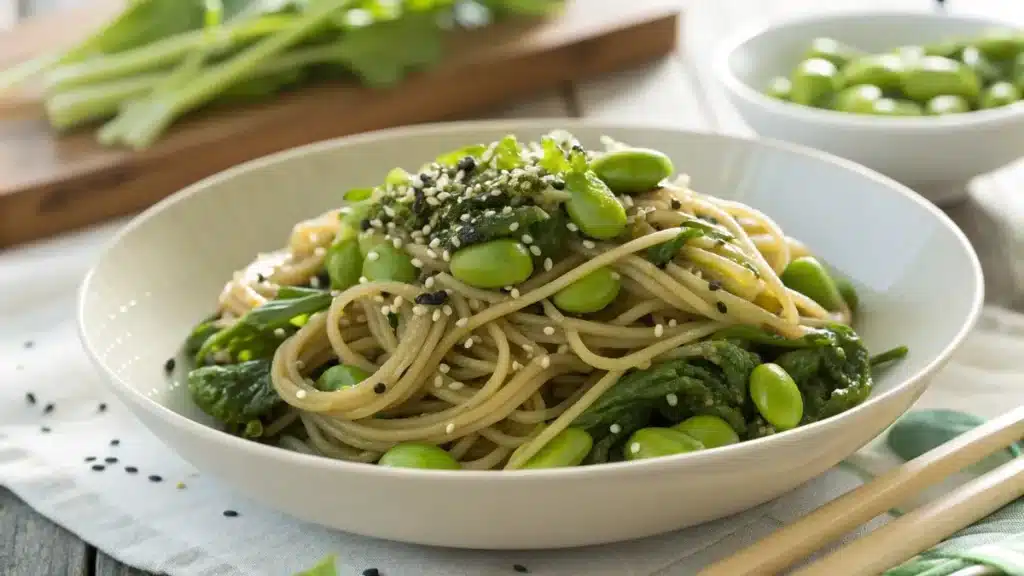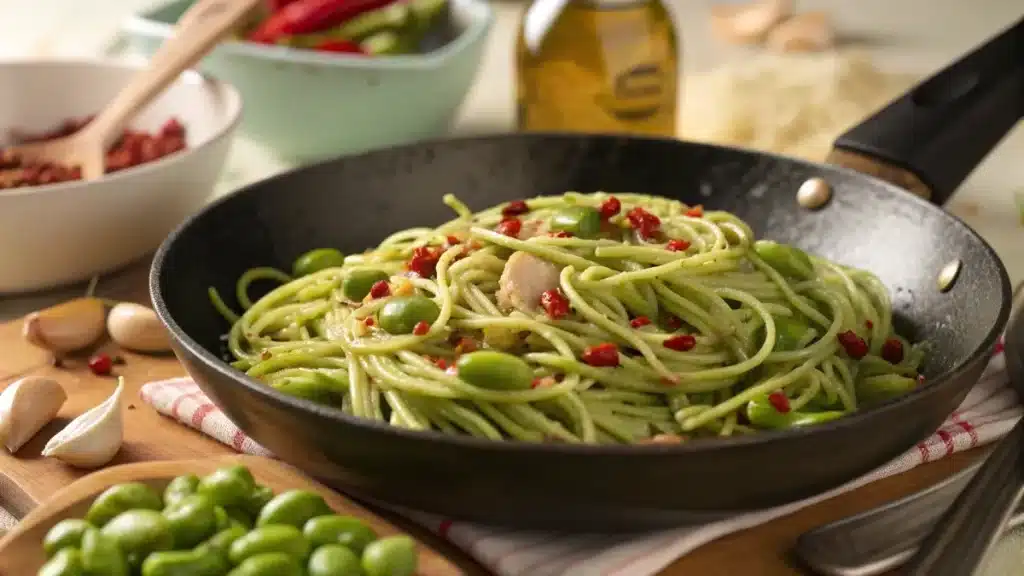Edamame Spaghetti Recipe: The Ultimate Guide to a Healthy, Protein-Packed Pasta Dish
Are you looking for a delicious way to enjoy pasta without compromising your health goals? If so, edamame spaghetti recipe ideas could be exactly what you need. This unique pasta alternative is gaining popularity for its high protein content, low carbs, and gluten-free goodness. In this guide, we’ll cover everything from what edamame spaghetti is to how to make a mouth-watering dish at home. We’ll also explore health benefits, address common questions, and offer plenty of tasty tips to make your next pasta night both nutritious and satisfying. Learn more about easy edamame recipes if you’re looking to diversify your plant-based cooking!
Table of Contents
Introduction to Edamame Spaghetti
What is edamame spaghetti?
Edamame spaghetti offers a nutritious twist on classic pasta by using young green soybeans, known as edamame, as its main ingredient. Unlike conventional wheat-based noodles, this pasta alternative is completely grain-free and flour-free. The process involves drying and milling edamame beans into a smooth powder, which is then formed into striking green spaghetti strands. This vibrant pasta not only adds color to your plate but also delivers a rich source of plant-powered protein.
You might wonder why so many health enthusiasts are raving about this pasta. One major reason is its impressive nutritional profile. Edamame spaghetti is naturally rich in fiber, low in carbohydrates, and offers a substantial amount of protein per serving. Plus, it’s free from artificial additives or preservatives, which makes it a cleaner option compared to some processed pasta products.
The growing popularity of edamame pasta recipes
Over the past few years, edamame pasta has gone from a niche health food store item to a mainstream pantry staple. Part of its appeal lies in its versatility—it pairs well with a wide variety of sauces, from creamy vegan Alfredo to spicy peanut. Another key reason behind its popularity is its suitability for different diets. Whether you follow a vegan, vegetarian, gluten-free, or low-carb lifestyle, edamame spaghetti can fit right in.
Additionally, as more people look for ways to incorporate plant-based protein into their diets, edamame spaghetti stands out as a smart and satisfying choice. Not only does it make mealtime exciting with its unique texture and color, but it also offers a nutritional boost that traditional pasta often lacks.
If you’re intrigued by the idea of adding this nutritious noodle to your meal rotation, stay tuned—we’re about to dive deeper into the many benefits of edamame spaghetti and show you how to prepare a dish that’s both simple and delicious.
Edamame Spaghetti Health Benefits
Is edamame spaghetti healthy?
Without a doubt, edamame spaghetti recipe options have earned a reputation as a healthier alternative to traditional pasta. But what makes them so good for you? First off, edamame spaghetti is naturally high in plant-based protein, making it a fantastic choice for anyone seeking to boost their protein intake without turning to animal products. In fact, a single serving often packs more protein than standard pasta made from wheat or rice.
Another standout feature is the fiber content. With its impressive fiber levels, edamame spaghetti helps promote digestive health, supports heart wellness, and keeps you feeling full longer. This means you’re less likely to overeat or snack between meals. And let’s not forget—edamame pasta is low in carbohydrates and free from added sugars, which can help support blood sugar control and weight management efforts.
If you’re following a gluten-free or low-carb diet, this pasta fits right in. It’s free from gluten, so it’s safe for individuals with celiac disease or gluten sensitivity. Plus, its low glycemic index means it won’t cause dramatic spikes in blood sugar, making it a smart pick for people looking to maintain steady energy levels throughout the day.
Check out gluten-free soft pretzels for another satisfying, gluten-free snack option.

Nutritional profile of edamame spaghetti
So, what exactly is in a serving of edamame spaghetti? Let’s break it down in this easy-to-read table:
| Nutrient | Per 2 oz Serving |
|---|---|
| Calories | ~180 |
| Protein | ~24 grams |
| Carbohydrates | ~20 grams |
| Dietary Fiber | ~12 grams |
| Fat | ~3 grams |
| Iron | ~4 mg (22% DV) |
| Calcium | ~60 mg (6% DV) |
As you can see, this pasta isn’t just about protein. It offers a balance of essential nutrients, including iron and calcium—both important for maintaining strong bones and preventing anemia. The combination of fiber and protein also makes edamame spaghetti incredibly filling, so a small portion goes a long way in satisfying hunger.
The high protein and fiber content work together to slow digestion, which helps stabilize blood sugar and reduce cravings. Additionally, edamame spaghetti is rich in antioxidants and phytonutrients that promote overall well-being.
Edamame Spaghetti as a Complete Protein
Is edamame spaghetti a complete protein?
If you’re aiming to follow a plant-based diet without missing out on essential amino acids, edamame spaghetti recipe creations are an excellent choice. Edamame, which is simply immature soybeans, naturally contains all nine essential amino acids your body needs. This makes edamame spaghetti one of the few plant-based pasta options that qualify as a complete protein.
That’s right—unlike pasta made from rice, corn, or lentils, edamame spaghetti can stand on its own in terms of delivering the full spectrum of amino acids required for muscle building, repair, and overall body function. This makes it a favorite among vegans, vegetarians, athletes, and anyone looking to boost their protein intake without animal products.
Moreover, since edamame spaghetti offers such a strong protein profile, it can help reduce your reliance on supplemental protein powders or additional protein-rich side dishes at meals. It simplifies your cooking while ensuring you’re still meeting nutritional needs. Discover great ideas like vegan breakfast burrito recipe if you want more high-protein, plant-based meal inspiration.
How edamame compares to other plant-based proteins
To give you a clearer picture, here’s a quick comparison between edamame spaghetti and other popular plant-based pasta options:
| Pasta Type | Protein (per 2 oz) | Complete Protein? |
|---|---|---|
| Edamame Spaghetti | ~24 grams | Yes |
| Lentil Pasta | ~13 grams | No |
| Chickpea Pasta | ~12 grams | No |
| Brown Rice Pasta | ~5 grams | No |
Clearly, edamame spaghetti stands out for both its protein content and its amino acid completeness. This makes it a superior option if you’re looking for a pasta that can serve as the main protein source in your meal.
In addition to protein, edamame spaghetti contains beneficial micronutrients like magnesium, folate, and iron—important for energy production, immune support, and overall health. And because it’s minimally processed, you get all these benefits without unnecessary additives.
Edamame Spaghetti and Gluten Concerns
Does edamame pasta have gluten?
One of the top reasons people seek out edamame spaghetti recipe ideas is because they need or prefer gluten-free options. You’ll be glad to know that edamame pasta is naturally gluten-free. Since it’s made entirely from edamame beans—no wheat, barley, or rye in sight—it’s safe for those with celiac disease or non-celiac gluten sensitivity. That means you can indulge in pasta night without the worry of hidden gluten causing discomfort or triggering health issues.
Beyond being gluten-free, edamame spaghetti is also free of common allergens like dairy and eggs, making it a fantastic choice for people with multiple dietary restrictions. However, it’s always a smart move to double-check packaging for potential cross-contamination warnings if you have severe allergies.
Don’t miss our garlic parmesan chicken pasta if you’re looking for a classic pasta dish you can adapt with edamame spaghetti for a gluten-free twist.
Safe choices for gluten-free diets
Edamame spaghetti isn’t the only option if you’re steering clear of gluten, but it’s certainly among the most nutritious. Let’s take a look at how it compares with other gluten-free pasta varieties:
| Gluten-Free Pasta | Protein (per 2 oz) | Fiber (per 2 oz) |
|---|---|---|
| Edamame Spaghetti | ~24 g | ~12 g |
| Brown Rice Pasta | ~5 g | ~2 g |
| Corn Pasta | ~6 g | ~2 g |
| Quinoa Pasta | ~8 g | ~3 g |
As you can see, edamame spaghetti shines not just for being gluten-free but also for offering more protein and fiber per serving compared to many other gluten-free options. This means you get a more filling and nutritionally balanced meal, all while sticking to your dietary needs.
Another great gluten-free pantry staple you might want to try is coconut milk for creamy sauces—looking for inspiration? Try how to make coconut milk to add a silky touch to your edamame spaghetti dishes.
Ingredients & Composition
What is edamame spaghetti made of?
At its core, edamame spaghetti recipe creations are all about simplicity. Edamame spaghetti is typically made from just one or two ingredients: edamame bean flour and sometimes water. That’s it—no fillers, preservatives, or artificial additives. The edamame beans (young green soybeans) are harvested, dried, and ground into flour. This flour is then shaped into spaghetti-like strands and dried again to create the final pasta product.
This minimalist ingredient list is a big reason why edamame spaghetti is considered a clean-eating option. With no hidden extras, you’re getting a food that’s close to its natural form. It’s a pasta that not only fits well into plant-based and gluten-free diets but also appeals to those seeking whole-food, minimally processed options.
In addition, edamame spaghetti is rich in naturally occurring nutrients like iron, folate, and potassium, thanks to its sole ingredient—edamame beans. Because nothing is stripped away or added in, the pasta retains the healthful benefits of the beans themselves.
How edamame spaghetti is produced
The production of edamame spaghetti starts on the farm, where young soybeans are harvested at peak freshness. These edamame beans are then steamed or blanched to preserve their vibrant green color and nutritional value before being dried thoroughly. Once dried, the beans are milled into a fine flour, which forms the base of the pasta.
Unlike wheat-based pasta, no eggs or binding agents are needed. The natural starches and proteins in the edamame flour allow the noodles to hold their shape beautifully during cooking. The flour is simply mixed with water (if needed), extruded into spaghetti strands, and dried. This streamlined process keeps the pasta free from unnecessary additives and helps preserve the bean’s nutrient density.
This clean, straightforward process ensures that what you’re putting on your plate is wholesome and true to its plant-based origins. And since edamame spaghetti is minimally processed, you’re also getting plenty of fiber, protein, and other beneficial nutrients intact.
Blood Sugar Impact of Edamame Spaghetti
Does edamame pasta spike blood sugar?
If you’re mindful of your blood sugar levels, you’ll be happy to hear that edamame spaghetti recipe dishes are an excellent choice. Thanks to its low glycemic index, edamame spaghetti is less likely to cause blood sugar spikes compared to traditional wheat pasta or even some gluten-free varieties like rice pasta. The combination of high fiber and protein content works together to slow down the digestion of carbohydrates. As a result, glucose enters your bloodstream at a steadier rate, helping maintain balanced energy levels.
For people living with diabetes or those following a low-carb lifestyle, this makes edamame spaghetti a smart and satisfying pasta swap. Each serving offers roughly 12 grams of fiber, which helps regulate blood sugar and keeps you feeling full for longer.
What’s more, edamame spaghetti contains no added sugars or refined flours. This means your meal won’t be loaded with empty carbs that can lead to quick blood sugar highs and subsequent crashes.
Glycemic index and diabetic-friendly pasta options
You may be wondering how edamame spaghetti stacks up against other pasta choices when it comes to blood sugar impact. Here’s a quick comparison to help you see the difference:
| Pasta Type | Approximate Glycemic Index |
|---|---|
| Edamame Spaghetti | ~30 (Low GI) |
| Whole Wheat Pasta | ~50 (Medium GI) |
| White Pasta | ~60 (Medium-High GI) |
| Rice Pasta | ~70 (High GI) |
Clearly, edamame spaghetti sits firmly in the low GI category, making it a preferred choice for those who want to keep their blood sugar stable. Pairing it with healthy fats like olive oil or protein-packed toppings like tofu can enhance its blood sugar-friendly profile even further.
Don’t miss our gluten-free cereal guide for more ideas on low-GI foods that support balanced blood sugar.
Edamame vs. Soybeans
Is edamame healthier than soybeans?
A frequent question when trying out edamame spaghetti recipes is whether edamame is healthier than fully mature soybeans. The nutritional benefits vary based on what you prioritize. Both edamame and mature soybeans originate from the same plant but are picked at different growth phases. Edamame consists of young, tender, green beans, whereas mature soybeans are firmer and have a beige hue.
Edamame tends to be lower in calories and fat compared to mature soybeans. It’s also a bit sweeter in flavor and easier to digest for some people. Because edamame is harvested earlier, it contains higher levels of certain nutrients like folate and vitamin K. These nutrients play important roles in cell growth, blood clotting, and bone health.
From a protein perspective, both edamame and soybeans are complete proteins. However, edamame provides a lighter, fresher taste that pairs beautifully with pasta dishes like edamame spaghetti. Plus, the texture of edamame-derived products, including spaghetti, is often more tender and palatable compared to items made from mature soybeans.
Comparing nutritional content and health impact
Let’s break down how edamame and mature soybeans compare in a simple table:
| Nutrient (per 1 cup cooked) | Edamame | Soybeans |
|---|---|---|
| Calories | ~190 | ~300 |
| Protein | ~18 g | ~28 g |
| Fat | ~8 g | ~15 g |
| Fiber | ~8 g | ~10 g |
| Folate | ~482 mcg | ~93 mcg |
As shown, edamame shines when you want a lower-calorie, lower-fat option that’s still rich in essential nutrients. That’s why edamame spaghetti is often considered a healthier pick when compared to pasta products made from mature soybeans or other processed soy ingredients. It gives you the protein punch without excessive calories or fats.
Another benefit? The milder taste of edamame spaghetti makes it versatile enough for both bold sauces and light dressings. So whether you’re craving a spicy kick or a delicate garlic olive oil drizzle, edamame spaghetti adapts beautifully.
The Ultimate Edamame Spaghetti Recipe

Simple edamame spaghetti recipe step-by-step
Now that you know all about the health benefits and unique qualities of edamame spaghetti, it’s time to bring it to your table. Here’s a no-fuss edamame spaghetti recipe that’s perfect for busy weeknights yet impressive enough for guests.
Ingredients:
- 8 oz edamame spaghetti
- 2 tablespoons olive oil
- 3 cloves garlic, minced
- 1 cup cherry tomatoes, halved
- 1/4 cup fresh basil, chopped
- 1/4 teaspoon red pepper flakes (optional)
- Juice of 1/2 lemon
- Salt and pepper to taste
- Freshly grated vegan Parmesan (optional)
Directions:
- Prepare the edamame spaghetti by bringing a large pot of salted water to a rolling boil. Add the edamame noodles and cook them as directed on the package, typically for 4 to 6 minutes. Once cooked, drain the pasta thoroughly and set it aside for your next step.
- Sauté the aromatics. In a large skillet, heat olive oil over medium heat. Add minced garlic and red pepper flakes, cooking until fragrant (about 1 minute).
- Add veggies. Stir in the cherry tomatoes and continue cooking for 3 to 4 minutes, until they start to soften and their juices begin to flow.
- Combine everything. Add the cooked edamame-spaghetti to the skillet. Toss with the garlic-tomato mixture, lemon juice, and fresh basil. Season with salt and pepper to taste.
- Serve and enjoy. Top with vegan Parmesan if desired, and serve warm!
This dish is light, fresh, and loaded with plant-based goodness. It’s quick to prepare, nutrient-dense, and endlessly customizable.
Customizations: vegan, keto, or spicy versions
The beauty of this edamame spaghetti recipe is its flexibility. Here are a few easy tweaks to fit different dietary needs:
- Vegan: The base recipe is already vegan, but you can add marinated tofu, roasted chickpeas, or a drizzle of tahini for extra protein and creaminess.
- Keto-friendly: While edamame spaghetti is low in carbs compared to wheat pasta, you can reduce carbs further by loading up on low-carb veggies like zucchini, spinach, or mushrooms.
- Spicy: Turn up the heat by adding more red pepper flakes, fresh chili, or a splash of hot sauce.
Pair your edamame spaghetti with a side of steamed greens or a crisp salad for a complete, balanced meal. The possibilities are endless, so don’t be afraid to get creative!
Tips, Serving Ideas & Storage
Best sauces and toppings for edamame spaghetti
One of the best things about any good edamame spaghetti recipe is its ability to pair with a variety of sauces and toppings. The mild, slightly nutty flavor of edamame noodles complements both bold and subtle accompaniments. Here are some delicious ideas to get you started:
- Light olive oil and garlic drizzle – Effortless, refined, and fast to prepare.
- Creamy vegan Alfredo – Blend cashews, nutritional yeast, garlic, and plant milk for a luscious sauce.
- Spicy peanut sauce – Perfect if you’re craving something with an Asian-inspired kick.
- Pesto – Fresh basil, pine nuts, and a splash of lemon make for a bright, herby pairing.
- Miso-ginger glaze – A sweet-savory glaze that brings an umami boost.
For toppings, consider roasted chickpeas, sautéed mushrooms, hemp seeds, or crumbled vegan feta for extra texture and nutrition.

How to store and reheat edamame spaghetti
Leftovers? No problem. Here’s how to keep your edamame spaghetti recipe creations tasting great:
- Storage: Place cooled spaghetti in an airtight container. Refrigerate for up to 3 days. Avoid leaving it out at room temperature for long periods to maintain food safety.
- Reheating: For best results, reheat gently on the stovetop over medium heat with a splash of water or broth to loosen the noodles. Alternatively, microwave in short intervals, stirring in between.
Pro tip: Edamame-spaghetti tends to soak up sauce as it sits. When reheating, you might want to add a little extra sauce or olive oil to refresh the dish.
With these simple tips, your edamame spaghetti will be just as enjoyable the next day—maybe even better as the flavors meld!
Conclusion
Edamame spaghetti is more than just a pasta substitute—it’s a delicious, nutrient-dense food that can support a variety of health goals. Whether you’re after a high-protein meal, need gluten-free options, or want to keep blood sugar levels steady, this green noodle checks all the boxes. It’s easy to prepare, endlessly customizable, and pairs well with a wide range of sauces and toppings. Don’t miss our gluten-free cereal guide for more smart choices for your pantry!
Ready to bring the goodness of edamame-spaghetti into your kitchen? Start experimenting today—you’ll be amazed at how satisfying and versatile this pasta can be!
FAQs
Is edamame spaghetti healthy?
Yes! Edamame-spaghetti is considered a very healthy pasta alternative. It’s packed with plant-based protein, rich in dietary fiber, and low in carbohydrates compared to traditional pasta. It’s also gluten-free and minimally processed, making it a smart choice for those focusing on whole, nutrient-dense foods.
Is edamame spaghetti a complete protein?
Absolutely. Edamame-spaghetti is made from edamame beans, which are young soybeans. This means it contains all nine essential amino acids, qualifying as a complete protein—perfect for vegetarians, vegans, and anyone looking to up their protein intake with plant-based foods.
Does edamame pasta have gluten?
Nope! Edamame pasta is naturally gluten-free. It contains no wheat, rye, or barley, making it a safe and nutritious option for those with celiac disease or gluten sensitivity.
What is edamame spaghetti made of?
Edamame-spaghetti is typically made from edamame bean flour, sometimes with water as the only additional ingredient. That’s it—no additives, fillers, or artificial ingredients. This keeps it clean, simple, and nutrient-packed.
Does edamame pasta spike blood sugar?
Not at all. Edamame pasta has a low glycemic index, meaning it’s less likely to cause rapid spikes in blood sugar. Its high fiber and protein content work together to slow digestion and keep blood sugar levels stable.
Is edamame healthier than soybeans?
Both edamame and soybeans are nutritious, but edamame is generally lower in calories and fat, and higher in certain vitamins like folate. Many people find edamame easier to digest and more versatile for dishes like edamame-spaghetti.

